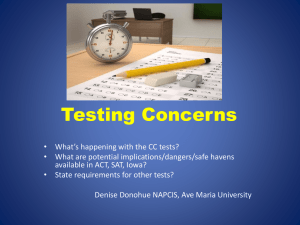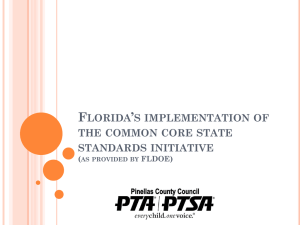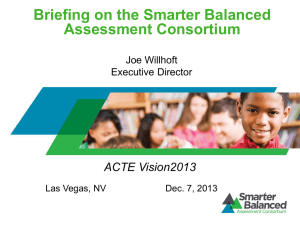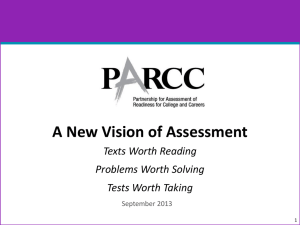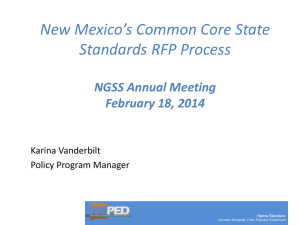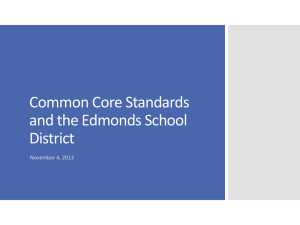the PPT - Center for Public Education
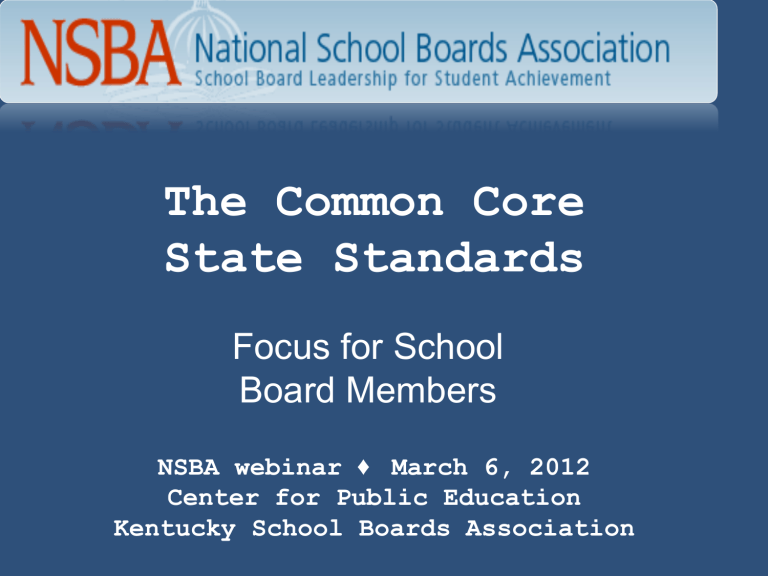
The Common Core
State Standards
Focus for School
Board Members
NSBA webinar ♦ March 6, 2012
Center for Public Education
Kentucky School Boards Association
Today’s presenters
• Patte Barth, NSBA’s Center for Public Education
• Roberta Stanley, NSBA’s federal relations
• Bill Scott, Kentucky School Boards Association
• Kerri Schelling, KSBA
The Common Core Standards are intended to be:
• Aligned with college and work expectations
• Focused and coherent
• Include rigorous content and application of knowledge through high-order skills
• Build upon strengths and lessons of current state standards
• Internationally benchmarked so that all students are prepared to succeed in our global economy and society
• Based on evidence and research
• State led – coordinated by NGA Center and CCSSO
3
SOURCE: Common Core State Standards, www.corestandards.org
The Common Core Standards process:
• CCSSO and NGA’s Center for Best Practices
• Advisory group: Achieve, Inc.; ACT, Inc.; College
Board, NASBE, and SHEEO
• Two rounds of public review
• Final documents released June 2010
• No federal dollars for development; foundation support
46 states & DC have adopted the CCSS adopted not adopted
5
CCSS vs NCLB
Common Core State Standards No Child Left Behind
INFLEXIBLE on CONTENT states must adopt 100% of CCSS K-12 standards
INFLEXIBLE on ASSESSMENT must begin assessments on CCSS within three years
FLEXIBLE on ACCOUNTABILITY no requirements for public accountability
FLEXIBLE on CONTENT states define their own standards
INFLEXIBLE on ASSESSMENT must assess state standards yearly 3-8 and once in high school
INFLEXIBLE on ACCOUNTABILITY numerous provisions
NSBA & CCSS
• supports NGA/CCSSO state-led process
• supports federal funding for research and/or help to states for developing assessments
• opposes federal mandates or coercion, eg. a condition for receiving Title 1 funds
• opposes a national test
What’s in the standards –
English language arts
Reading
• Balance of literature and informational texts
• Text complexity
Writing
• Emphasis on argument/informative
• Writing about sources
Speaking and Listening
• Inclusion of formal and informal talk
Language
• Stress on general academic and domain-specific vocabulary
SOURCE: Common Core Standards, June 2010
What’s different? English language arts
Standards for reading and writing in history/ social studies, science, and technical subjects
• Complement rather than replace content standards in those subjects
• Responsibility of teachers in those subjects
Alignment with college and career readiness expectations
SOURCE: Common Core Standards, June 2010
What’s in the standards –
Mathematics
• Number & quantity
• Algebra algebraic thinking K-5
• Functions
• Modeling high school
• Geometry
• Statistics & probability
• Emphasis on Mathematical practice
SOURCE: Common Core Standards, June 2010
What’s different? –
Mathematics
Modeling -- choosing and using mathematics and statistics to represent and analyze everyday situations to understand them better
Eg., planning a table tennis tournament for 7 players with 4 tables and everyone plays each player
SOURCE: Common Core Standards, June 2010
Pathways through high school mathematics pre-calculus, calculus, advanced statistics, discrete math, advanced quantitative reasoning, specific technical POS
Algebra II
Geometry
Algebra I
Math III
Math II
Math I
Traditional sequence
•
2 algebra courses
• 1 geometry course
• DPS included
• 1 higher course
Integrated sequence
•
3 integrated courses
• all include number, algebra, geometry, DPS
• 1 higher course
SOURCE: Common Core Standards, Mathematics Appendix A, 2010
State CCSS assessment consortia
• formed to develop common “next generation” assessments aligned to the CCSS
• supported by $346 million federal grants
• PARCC : Partnership for Assessment of Readiness for
College & Careers headed by Achieve, Inc.
• SMARTER Balanced Assessment Consortium headed by
Washington state department of education
13
What’s in common?
• intended to assess higher order thinking at grades 3-8 and high school
• measure growth and proficiency
• computer-administered online to provide rapid feedback
• both summative assessments for accountability, and formative assessments to monitor students’ progress
• aligned resources, ie., model lessons, diagnostic tools, professional development
14
How do PARCC/SMARTER differ?
• PARCC is computer-delivered; SMARTER will be
“computer adaptive”
• SMARTER is developing comprehensive high school assessment; PARCC is developing EOC high school assessments, including for two math pathways
• SMARTER is budgeted to translate assessments into 5 languages, one of which will be Spanish
15
Points of collaboration
SMARTER & PARCC
• working to ensure comparability of scores
• developing protocols for Artificial Intelligent scoring
• examining interoperable technology infrastructure
• working toward same deadlines
16
SOURCE: Center for K-12 Assessment & Performance Management at ETS, webinar April 4, 2011
24 states & DC are in the PARCC consortium participant non participant
17
28 states are in the SMARTER consortium participant non participant
18
46 states & DC are involved involved not involved
19
Next Generation Science
Standards
• Collaboration of Achieve, NRC, AAAS, NSTA and 26 lead states
• “Internationally benchmarked”
• First draft to be released in 2012; 2 public reviews
• Intended to be adopted ‘in whole’
• Carnegie Corp, Noyce Foundation & Dupont sponsors
20
What will be in the standards
Science
• Practices: behaviors necessary to the work of scientists & engineers
• Cross-cutting concepts: the ‘big ideas’, eg., patterns, scale, cause
& effect, etc.
• Disciplinary core ideas: physical sciences; life sciences, earth & space sciences; and engineering, technology & applications.
SOURCE: Next Generation Science Standards, www.nextgenscience.org
21
26 lead states – Next Generation
Science Standards participant non participant
22
Other assessment consortia
• Alternative assessments : $67 million to Dynamic
Learning Maps (DLM) and National Center and State
Collaboration (NCSC)
– Assessments for students with “most significant cognitive impairments”
• Assessments for ELL : $10.5 million to ASSETS,
Assessment Services Supporting Els Through
Technology Systems
SOURCE: The K-12 Center at ETS, www.k12center.org
23
The Common Core
State Standards
The challenges
ACT’s ‘first look’ at the common core standards
English language arts
Percent of 2009 11 th graders scoring at college-career ready benchmark
SOURCE: ACT, Inc., A First Look at the Common Core and College and Career Readiness, December 2010
25
ACT’s ‘first look’
Achievement gap - ELA
Percent of 2009 11 th graders scoring at college-career ready benchmark
SOURCE: ACT, Inc., A First Look at the Common Core and College and Career Readiness, December 2010
26
Technology needs
• 33 states offer some level of online testing
• Most don’t assess all students
• Most are voluntary
• Most are summative only
• Most schools will need more computers & more bandwidth
SOURCE: SETDA, Technology Requirements for Large Scale, Computer-Based & Online Assessment, June 2011
27
District needs
• Professional development for staff
• Aligned assessments & curriculum
• Aligned instructional materials
• Supports for students
28
The Common Core
State Standards
How states are preparing
State survey
• Most states say CCSS are more rigorous than their current standards
• Most states say full implementation will take at least until
2013 or beyond
• All are developing professional development materials & guides for districts
SOURCE: Year 2 of implementing common core state standards: States ’ progress and challenges, Center on Education Policy, January 2012
State survey (con’t)
• Most states have established partnerships between state education agency and higher ed
• Half are aligning undergraduate admissions policies with
CCSS
SOURCE: Year 2 of implementing common core state standards: States ’ progress and challenges, Center on Education Policy, January 2012
School district challenges
• Almost 3/5 of districts in CCSS states view CCSS as more rigorous
• 2/3 are developing plans and timelines
• 3/4 view adequate funding as a major challenge
• 2/3 say they are getting inadequate guidance from state
• Few see teacher/principal resistance as a major challenge although 3/5 see it as a minor one
SOURCE: Common Core State Standards: Progress and Challenges in School Districts’ Implementation, Center on Education Policy,
September 2011
The Common Core
State Standards
The federal view
Federal Policy and CCSS
Race to the Top
• One of four reform areas: standards & assessments.
• States do not have to adopt common standards to be eligible; but get points for doing so, more points for joining larger consortium
(e.g. CCSSO/NGA).
• Points for supporting transition to new standards/assessments.
• Same criteria applied to assessments.
• Make up 70 points of 500 points total.
• 11 states and DC received RTTT funds (I and II), 9 more states eligible for phase III.
Federal Policy and CCSS
NCLB waivers
• ED announced waivers 9-23-2011.
• 10 broad areas of flexibility include: waive 2014 deadline of 100% proficiency; waive identification of schools for improvement; free up
20% set-aside for choice and tutoring, 10% for professional development, etc.
• In exchange for four reform principles, include: develop and implement rigorous college- & career-ready standards & assessments in reading & math.
• Adopt English language proficiency standards aligned to new standards and assessments.
• Flexibility through 2013-2014 school year, can apply for extension.
Federal Policy and CCSS
College- and career- ready standards must be:
• Standards that are common to a significant number of states (states can supplement up to 15% with additional standards for a content area); or
• Standards that are approved by a “state network of institutions of higher education”, certify students will not need remedial courses (a network of 4-year IHEs that enroll at least 50% of students who attend state’s 4-year public IHEs).
High quality assessments must be:
• Valid, reliable and fair; measure college & career readiness.
• Measure student growth.
Passage of Senate Bill 1 in 2009 propelled Kentucky into a new era in public education
Mutual accountability for K-12 and post secondary systems
Preparing all students for life after high school…
◦ college and career readiness for all.
37
Senate Bill 1 (2009)
New academic standards
New assessments
Program reviews
Improved professional development
New accountability system
Unified plan for improving college/career readiness
38
38
90% of school.
fastest growing jobs require at least two (2) years of education beyond high
80% of all jobs require some training beyond high school.
Nation’s colleges need to increase number of degrees by 10% per year to meet demand.
Kentucky = 5,200 more graduates per year
39
High School Graduation Rate = 76%
38 % of Kentucky’s 2011 high school graduates were College or Career Ready
High remediation rate = fewer college degrees
40
Added cost with no credits
Adds time/expense to college education
Result: more likely to leave w/o diploma
College freshmen requiring remedial reading have 17% chance of attaining degree in 8 years
41
College Ready Criteria
Must meet one of the following requirements to be considered College Ready:
ACT (11 th Grade)
English – 18
Mathematics – 19
Reading – 20
COMPASS (12 th Grade)
KYOTE (12 th Grade)
42
College Readiness System
ACT’s College Readiness Benchmarks* are early indicators of likely college success based on student EXPLORE, PLAN, or ACT scores.
Test Content Area EXPLORE
8th
English English 13
PLAN
15
10th
ACT
11th
18
Math Algebra 17
Reading Social Sciences 15
19
17
19
20
Science Biology 20 21 24
* Reflects the minimum score needed on an ACT subject area test to indicate a 50% chance of obtaining a “B” or better or a 75% chance of obtaining a “C” or better in the corresponding credit-bearing college course.
43
Career Ready Criteria
Must meet one benchmark for academic area and one for technical area.
Academic: a) Armed Services Vocational Aptitude Battery
(ASVAB) b) ACT Work Keys (applied math, locating information and reading for information)
Technical: a) Kentucky Occupational Skills
Standards Assessment
(KOSSA) b) Industry certificates
44
1. Course/Assessment Alignment with Standards
2. Transitional Interventions
3. Acceleration o Advance KY o Project Lead the Way
4. Persistence to Graduation –-
Collection and Use of Data
5. Academic and Career Advising
6. Career Readiness Definition/Pathways
7. Innovative Routes To Graduation
8. District 180/Turnaround Low Performing Schools
9. New Accountability Model
45
10 years of research by Iowa Association of School Boards and NSBA
Do school boards make a difference in student achievement?
What are the specific board roles that impact student achievement?
Set clear and high expectations
Create the conditions for success
Hold the system accountable
Create the public will to succeed
Learn as a board team
Embrace the new standards!
−
−
Clearer and more rigorous
Focused on specific knowledge and skills necessary for postsecondary success
How much does your board know about new standards?
Support high quality professional development
−
−
Do teachers have sufficient time and support to learn new standards?
What can the board do to support this effort?
Monitor district’s progress toward successful implementation of the new standards
What is the district doing to prepare?
What kind of reports does the board receive?
Help public understand significance of new standards
Engage local media in your efforts
Include relevant topics on board agendas & work sessions
Use multiple sources of information
⁻
₋
₋
Kentucky Department of Education
Kentucky Educational Television
Prichard Committee – “Ready Kentucky”
Partnerships with state agencies and organizations (accurate/timely/consistent information)
Whole board training modules
Statewide training opportunities
Facilitation of community discussions
Bill Scott, executive director
Bill.scott@ksba.org
Kerri Schelling, director, board team development
Kerri.schelling@ksba.org
Kentucky School Boards Association www.ksba.org
Learn more
NSBA resources
Race to the Top www.nsba.org/economicstimulus
NCLB waivers
Conference calls, weekly highlights, Webinar www.nsba.org/advocacy kbranch@nsab.org
U.S. Department of Education Website http://www.ed.gov/esea/flexibility
Watch this space
www.centerforpubliceducation.org
or contact
Patte Barth, pbarth@nsba.org

